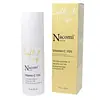What's inside
What's inside
 Key Ingredients
Key Ingredients

 Benefits
Benefits

 Concerns
Concerns

 Ingredients Side-by-side
Ingredients Side-by-side

Water
Skin ConditioningAscorbic Acid
AntioxidantGlycerin
HumectantCoco-Caprylate/Caprate
EmollientPrunus Amygdalus Dulcis Oil
Skin ConditioningSodium Ascorbyl Phosphate
AntioxidantTriethanolamine
BufferingAscorbyl Glucoside
AntioxidantRosa Canina Fruit Oil
EmollientLauryl Glucoside
CleansingPolyglyceryl-2 Dipolyhydroxystearate
Skin ConditioningXanthan Gum
EmulsifyingCellulose
AbsorbentHectorite
AbsorbentCitric Acid
BufferingDehydroacetic Acid
PreservativeBenzyl Alcohol
PerfumingWater, Ascorbic Acid, Glycerin, Coco-Caprylate/Caprate, Prunus Amygdalus Dulcis Oil, Sodium Ascorbyl Phosphate, Triethanolamine, Ascorbyl Glucoside, Rosa Canina Fruit Oil, Lauryl Glucoside, Polyglyceryl-2 Dipolyhydroxystearate, Xanthan Gum, Cellulose, Hectorite, Citric Acid, Dehydroacetic Acid, Benzyl Alcohol
Water
Skin ConditioningGlycerin
HumectantEthylhexyl Dimethyl Paba
UV AbsorberGlyceryl Stearate Se
EmulsifyingNiacinamide
SmoothingAscorbic Acid
AntioxidantEthylhexyl Salicylate
UV AbsorberCetearyl Alcohol
EmollientButyl Methoxydibenzoylmethane
UV AbsorberCoco-Caprylate/Caprate
EmollientCaprylic/Capric Triglyceride
MaskingGlyceryl Stearate
EmollientCeteareth-20
CleansingCeteareth-12
EmulsifyingCetyl Palmitate
EmollientPanthenol
Skin ConditioningPropylene Glycol
HumectantPhenoxyethanol
PreservativeButylene Glycol
HumectantCarbomer
Emulsion StabilisingPolysorbate 20
EmulsifyingPalmitoyl Tripeptide-1
Skin ConditioningPalmitoyl Tetrapeptide-7
Skin ConditioningSodium Lactate
BufferingAllantoin
Skin ConditioningTriethanolamine
BufferingAcrylates/C10-30 Alkyl Acrylate Crosspolymer
Emulsion StabilisingTocopheryl Acetate
AntioxidantTerephthalylidene Dicamphor Sulfonic Acid
UV AbsorberParfum
MaskingDisodium EDTA
Water, Glycerin, Ethylhexyl Dimethyl Paba, Glyceryl Stearate Se, Niacinamide, Ascorbic Acid, Ethylhexyl Salicylate, Cetearyl Alcohol, Butyl Methoxydibenzoylmethane, Coco-Caprylate/Caprate, Caprylic/Capric Triglyceride, Glyceryl Stearate, Ceteareth-20, Ceteareth-12, Cetyl Palmitate, Panthenol, Propylene Glycol, Phenoxyethanol, Butylene Glycol, Carbomer, Polysorbate 20, Palmitoyl Tripeptide-1, Palmitoyl Tetrapeptide-7, Sodium Lactate, Allantoin, Triethanolamine, Acrylates/C10-30 Alkyl Acrylate Crosspolymer, Tocopheryl Acetate, Terephthalylidene Dicamphor Sulfonic Acid, Parfum, Disodium EDTA
Ingredients Explained
These ingredients are found in both products.
Ingredients higher up in an ingredient list are typically present in a larger amount.
Ascorbic Acid is is pure Vitamin C. This form makes up the largest amount of vitamin C found naturally in our skin.
Not only is vitamin C great for your overall health and immune system, it also has plenty of benefits on your skin.
Vitamin C is best used for brightening skin. It improves dark spots, acne scars, and hyperpigmentation. This is because it blocks the process of skin darkening when exposed to UV.
Remember: Vitamin C should not replace sunscreen!
Your skin uses vitamin C to build collagen. Collagen is one key component in having a strong skin barrier and plump skin. Vitamin C also plays a role in regulating collagen, thus making it effective in improving wrinkles and fine lines.
Ascorbic acid shows potent antioxidant activity. As an antioxidant, it helps fight free-radicals. Free-radicals are molecules that may damage your skin cells. These antioxidants also protect skin against UV damage.
The best formulations include Vitamin E and/or ferulic acid. These two ingredients help stabilize and provide a boost in the benefits of ascorbic acid. This is because ascorbic acid becomes unstable when exposed to UV and air. In fact, you can tell your ascorbic acid has oxidized when it turns an orange-yellow color.
Ascorbic acid is generally compatible with other ingredients. However, using ascorbic acid with other active ingredients might cause irritation. Two ingredients: copper ions and benzoyl peroxide, will inactivate ascorbic acid completely.
Read more about other types of Vitamin C:
Foods rich with vitamin C include oranges, strawberries, broccoli, bell peppers, and more. When consuming Vitamin C, your skin receives a portion of the nutrients.
Learn more about Ascorbic AcidCoco-Caprylate/Caprate is created from fatty coconut alcohol, caprylic acid, and capric acid.
It is a lightweight emollient. Emollients create a thin barrier on the skin to trap moisture in. This helps keep your skin hydrated and soft.
Once applied, Coco-Caprylate/Caprate is absorbed quickly and leaves a silky feel.
Coco-Caprylate/Caprate may not be fungal acne safe.
Learn more about Coco-Caprylate/CaprateGlycerin is already naturally found in your skin. It helps moisturize and protect your skin.
A study from 2016 found glycerin to be more effective as a humectant than AHAs and hyaluronic acid.
As a humectant, it helps the skin stay hydrated by pulling moisture to your skin. The low molecular weight of glycerin allows it to pull moisture into the deeper layers of your skin.
Hydrated skin improves your skin barrier; Your skin barrier helps protect against irritants and bacteria.
Glycerin has also been found to have antimicrobial and antiviral properties. Due to these properties, glycerin is often used in wound and burn treatments.
In cosmetics, glycerin is usually derived from plants such as soybean or palm. However, it can also be sourced from animals, such as tallow or animal fat.
This ingredient is organic, colorless, odorless, and non-toxic.
Glycerin is the name for this ingredient in American English. British English uses Glycerol/Glycerine.
Learn more about GlycerinTriethanolamine is an emulsifier and pH adjuster. It is created using ethylene oxide and ammonia. This gives Triethanolamine a nitrogen core and a similar scent to ammonia.
As an emulsifier, it prevents ingredients from separating and enhances texture by adding volume to a product.
PH adjusters are common in cosmetic products. The pH of a product can affect the effectiveness of other ingredients. A product with a high pH may also irritate the skin.
Learn more about TriethanolamineWater. It's the most common cosmetic ingredient of all. You'll usually see it at the top of ingredient lists, meaning that it makes up the largest part of the product.
So why is it so popular? Water most often acts as a solvent - this means that it helps dissolve other ingredients into the formulation.
You'll also recognize water as that liquid we all need to stay alive. If you see this, drink a glass of water. Stay hydrated!
Learn more about Water